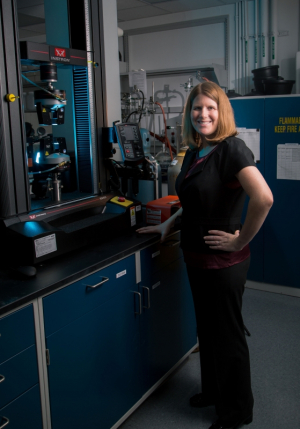Since its inception in 1989, an invitation to the Kavli Frontiers in Science Symposia has symbolized a young scientist’s vast accomplishments in his or her field. Each year, 80 to 100 of the world’s most outstanding scientists under the age of 45 are invited to the symposia, which are sponsored by the Kavli Foundation and the U.S. National Academy of Sciences (NAS).
This year, a chemical and biomolecular engineering professor at the UH Cullen College of Engineering was invited to participate in two Kavli Frontiers of Science Symposia.
Assistant professor Megan Robertson was among the 80 top young scientists invited to Indonesia last July to participate in the Indonesian-America Kavli Symposium. Robertson was also among the 25 scientists invited to participate as a speaker at the 27th Annual U.S. Kavli Frontiers of Science Symposium held in Irvine, California in November.
The overarching purpose of the Kavli Frontiers in Science symposia is to bring together researchers from a broad range of scientific backgrounds to engage in one-on-one discussions and forge new, interdisciplinary collaborations.
“These symposia give participants the opportunity to think about new topics and develop collaborations with people who we wouldn’t typically have the opportunity to meet,” Robertson said.
The Indonesian-American Kavli Symposia began in 2010 following a visit to the country by former NAS president Bruce Alberts. Serving as one of the first U.S. science envoys appointed by President Obama to strengthen scientific and technical collaboration between the U.S. and Muslim-majority nations, Alberts established the Indonesian Kavli Symposia with support from the U.S. State Department and the Kavli Foundation. The symposium series is co-organized by the NAS and the Indonesian Academy of Sciences (AIPI).
Symposia participants spent the first day in Indonesia taking a cultural tour that culminated in a visit to see the world’s oldest known cave paintings on the island of Sulawesi. Maxime Aubert, an archaeologist at Griffith University in Queensland, Australia who led the team that dated the 40,000 year-old paintings, gave a talk to the symposia group about the ancient artwork.
From there, the symposia speakers covered topics including marine microbiology, astrophysics and exoplanets, infectious diseases, and nanomaterials found in nature.
Robertson presented a general poster at the symposium relating to one of her laboratory’s core research areas: developing polymers from renewable resources, such as biomass and plant sources.
“This topic is very relevant to Indonesia because there is an emphasis on using available resources to grow the local industry,” Robertson said. “I am very hopeful that a collaboration between my lab group and researchers in Indonesia will result from this symposium.”
Robertson will travel to the Beckman Center of the National Academies of Sciences & Engineering in Irvine from November 5-7 for the U.S. Kavli Symposium, which will cover topics including personalized medicine, cyber security, behavioral economics, space, reverse-engineering the brain, and feedstocks for new materials.
As introductory speaker of one of the symposium’s sessions, “Utilizing New Feedstocks to Access the Next-Generation of Materials,” Robertson will present an overview focusing on the use of waste resources to develop polymers.
In addition to forging new collaborations with researchers from a broad range of scientific areas, Robertson said she is most looking forward to the question and answer sessions at the symposium.
“The Kavli Symposia are truly unique in their broad emphasis on a wide range of scientific topics as well as their format, which promotes interactions between attendees. There is a large emphasis on question and answer sessions in these symposia, and with a diverse audience present, fantastic questions are asked, oftentimes representing a different way of thinking about the problem,” Robertson said.
